Abstract
Alloy design of Cr-Co-Ni-Ta eutectic medium entropy alloys (EMEAs) was performed through a CALPHAD method coupled with experimental study, with the aim to attain high phase stability as well as excellent mechanical properties. Based on calculated pseudo-binary diagram, CrCoNiTax (x = 0.1, 0.3, 0.4, 0.5, 0.7) medium entropy alloys were investigated. Two phases, FCC solid solution and Laves phase, were identified in the alloys. With increasing Ta content, the volume fraction of hard and brittle Laves phase increased, microstructure changed from hypoeutectic (Ta0.1, Ta0.3) to eutectic (Ta0.4) and then to hypereutectic (Ta0.5, Ta0.7). The stability of phases was assessed by considering the thermodynamic parameter Ω and valence electron concentration (VEC). The eutectic phases become stable when 1.42 < Ω < 0.74 and 7.5 < VEC < 8.25. In addition, based on nanoindentation, the results indicated that solid solution strengthening in γ phase was significantly enhanced, eutectic phase in CrCoNiTa0.4 EMEA was found to process the highest microhardness and elastic modulus. Finally, the hardness of alloys was positively correlated with the content of Ta and the plastic strain of alloys obviously decreased, while the compression strength firstly increased and then decreased. CrCoNiTa0.4 was the most promising alloy with the highest compression strength (2502 MPa) and high plastic strain (20.6%).
1. Introduction
The design concept of the traditional alloy is mainly based on one or two elements, and a small number of other elements are added to optimize the performance. High-entropy alloys (HEAs), first reported in 2004, are novel high-performance metal materials with broad application potential which in recent years have become one of the research hotspots of metallic materials [1,2]. HEAs containing alloying elements with equal atomic content possess excellent mechanical properties, and the HEA concept represents a significant breakthrough in the compositional and structural design of alloys in physical metallurgy [3,4].
However, there are still gaps between experimental research and engineering applications. One of the problems is that with a single-phase it has been found challenging to reach an appropriate balance between strength and ductility [5]. Previous mechanical performance results indicated that the HEAs with FCC structures possessed superfluous ductility but low strength, while alloys with BCC structures have good strength but poor plasticity [6]; from the alloy preparation perspective, most HEAs are made by casting. The problem is the formation of as-cast defects, therefore engineering application and development of HEAs are limited [7,8]. In view of this, Lu et al. [9] designed an AlCoCrFeNi2.1 eutectic high-entropy alloy with a pearlite-like layer structure. In addition, the ordered BCC phase and Laves phase have been the strengthening phase in eutectic HEAs (EHEAs). Through appropriate alloy design, EMEAs with a lamellar structure, usually containing a high strength phase (intermetallic compound of BCC or HCP) and a high plasticity FCC phase [10,11,12]. EHEAs with FCC and Laves phases in the form of lamellae have been reported to excellent casting properties and fewer casting defects in the ingot [10,12]. Moreover, eutectic structures also have advantages of high temperature creep resistance, low-energy phase boundaries, and controllable microstructures [11]. As for Laves phase, the performance of M2Ta is superior to that of M2Nb which is the strengthening phase in CrCoFeNiNb0.65 EHEA [11]. Therefore, EHEAs strengthened by M2Ta Laves phase are expected to possess ideal mechanical properties.
The CrCoNi ternary alloy is a typical medium-entropy alloy (MEA) with FCC structure and the properties of CrCoNi have been reported to be significantly better than those of CrMnFeCoNi [13,14,15]. The CrCoNi MEA has been proved to be a single FCC solid solution, none of the composition fluctuations or long-range order are observed [13]. Recently, the study by Ai [12] showed that the CoCrFeNi quinary HEA was modified into a eutectic alloy successfully by adding Ta elements. We systematically evaluated the alloying elements in Cr, Co, Ni and found eutectic reactions existed in Cr-Ta [16], Co-Ta [17], and Ni-Ta [18] simultaneously. Luckily, all the eutectic points in binary alloy systems are located approximately at 11% atomic percentage. Accordingly, CrCoNiTax MEAs can be designed into eutectic microstructures. Since the atomic radius of Ta is significantly larger than that of the other three elements—Cr, Co and Ni—the addition of Ta enhances solid solution strengthening and further strengthens the alloy based on the FCC structure. In addition, Ta is a powerful factor for solid solution strengthening and precipitation strengthening in γ/γ’ structured Ni-based and new Co-based superalloys [19,20]. Furthermore, the diffusivity of Ta in Ni and Co is relatively low, implying that the CrCoNiTa with lamellar structure should possess great microstructural stability at elevated temperatures. Moreover, in the past few years, the use of computational phase diagram database software to predict the formation of phases has become an important means of alloy composition design and it is very effective in the design of HEAs [11,21,22]. Here we proposed to design CrCoNi EMEAs according to binary phase diagrams calculation by Thermo-Calc. The CrCoNiTax (x = 0.1, 0.3, 0.4, 0.5, 0.7) were prepared. Their microstructure, phase and micromechanical properties under nanoindentation conditions were reported.
2. Design Principle and Experimental Scheme
2.1. CALPHAD Modeling
Figure 1 shows the pseudo-binary diagram of CrCoNi-Ta calculated by the Thermo-Calc software (ThermoCalc, Stockholm, Sweden) based on Ni-based database TTNi7 (ThermoTech Ltd., Surrey, UK). It shows that the primary phase is γ for a hypoeutectic composition, the primary phase is the C14 Laves phase for a hypereutectic composition. The eutectic point of the EMEA alloy falls approximately at Ta-11% and CrCoNiTa0.4, which is in general agreement with the previously discussed viewpoints. So, we designed the CrCoNiTax (x = 0.1, 0.3, 0.4, 0.5, 0.7) alloys, chemical compositions are hypo-eutectic point (0.1), around eutectic point (0.3, 0.4, 0.5) and hyper-eutectic point (0.7), respectively. For convenience, the alloys were named by Ta0.1, Ta0.3, Ta0.4, Ta0.5, Ta0.7, respectively.
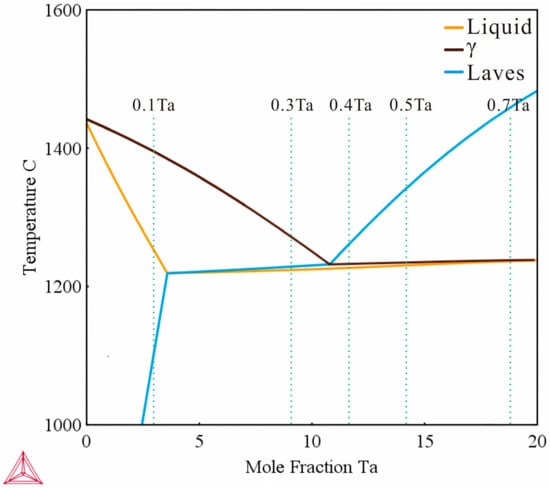
Figure 1.
The pseudo binary phase-diagram of CrCoNiTax alloys calculated from Thermo-Calc.
2.2. Experimental Scheme
Cr, Co, Ni and Ta were used to prepare CoCrNiTax alloys, the purities for those elements are approximately 99.9%, then subjected to be melted by using vacuum arc melting casting. Then the alloys were melted at least five times to obtain homogeneity. The crystal structures were characterized by an X-ray diffractometer (XRD D8 Discover, Bruker, Karlsruhe, Germany), using Cu K radiation scanning from 30° to 100° at the speed of 3°/min.
The samples were chemically etched by the aqua regia solution [HCl: HNO3 = 3:1 (in vol%)]. The microstructures were revealed using the scanning electron microscopy (SEM, Gemini 500, ZEISS, Jena, Germany) equipped with the energy-dispersive spectrometer (EDS) and electron backscattered diffraction (EBSD). The average hardness of MEAs were measured by a Vickers micro-hardness tester (HMV-T2) under a load of 1000 g for 15 s and 5 different points were tested on each sample. Nanoindentation tests were performed to measure the mechanical properties of each phase employing nanoindenter with a Berkovich diamond at room temperature (Ti980 Hysitron, Billerica, MA, USA). Compression tests were carried out on ø3 × 5 samples at room temperature using a material testing machine (INSTRON 3382) with a strain rate of 1.6 × 10−3 s−1 [16].
3. Results and Discussion
3.1. Microstructural Features
The microstructural evolution of the CrCoNiTax alloy is demonstrated in Figure 2. Some white precipitates with lamellar morphology were observed in the Ta0.1 alloy, and with increasing Ta addition, the volume fraction of the eutectic was significantly increased. Once the Ta addition reached 0.4, namely the Ta0.4 alloy, fully eutectic morphology with typical lamellar structure was obtained. When the Ta addition exceeded 0.4 and reached 0.5 and 0.7, namely the Ta0.5 alloy and Ta0.7 alloys, in addition to the eutectic structure with lamellar, some bulk primary phase appeared to increase. Combining the results from Figure 1, the morphologies of the Ta0.1 and Ta0.3 exhibited hypoeutectic structure while Ta0.5 and Ta0.7 exhibited hypereutectic structure. Ta content of eutectic point in CoCrNiTax alloys was 11.7 at.%. Compositions of the characteristic regions in alloys are shown in Table 1.

Figure 2.
SEM images of CrCoNiTax under as-cast microstructure; (a,b) = 0.1; (c,d) x = 0.3; (e,f) x = 0.4; (g,h) x = 0.5, (i,j) x = 0.7. Primary phase and eutectic under different compositions are marked.

Table 1.
Composition of characteristic regions in CrCoNiTax alloys (in at.%).
As given in Figure 1 and Figure 2, the increase in Ta content in MEAs causes a transition in the primary phase and corresponding change in volume fraction. A complete transformation from hypoeutectic to hypereutectic is observed. The primary phase in hypoeutectic is γ phase while in hypereutectic is Laves phase, respectively. The microstructure formation and phase selection in Figure 2 can be explained through the solidification process.
For the analysis combined with Figure 1, as for hypoeutectic eutectic Ta0.1 and Ta0.3 alloy, the γ phase is first nucleated during solidification process, the liquid and γ phase are in a mixed state until the eutectic temperature is reached. Subsequently, the temperature continues to decrease, the liquid phase switches to the eutectic point, and the eutectic reaction is triggered, forming γ/Laves lamellar eutectic microstructure. During the reaction, the γ phase and the Laves phase are coupled to grow and alternately arranged to produce lamellar structures. Finally, the structure consists of a mixture of primary γ phase and eutectic mixture of γ and Laves phases. In the CrCoNiTa0.4 alloy, once the temperature decreases down the point of eutectic reaction, the two phases nucleate at the same time and grow together. As for hypereutectic eutectic Ta0.5 and Ta0.7 alloys, the solidification process is similar to that of Ta0.1 and Ta0.3 alloys, but the first nucleated phase shifts to Laves phase. It possesses final microstructures of the primary Laves phase and the eutectic mixture of γ and Laves phases.
3.2. Phase Characterization
As eutectic medium entropy alloy Ta0.4 with fine lamellar structure was successfully designed. The calculation system (Figure 1) reveals that the phases in the alloy are γ and Laves, respectively.
We used XRD to further confirm the crystal structure. The XRD patterns of as-cast CrCoNiTax alloys are presented in Figure 3a. With the increasing Ta addition, more diffraction peaks of Laves phase are observed in the Ta0.3, Ta0.4, Ta0.5, Ta0.7 alloys. The crystal structure of Laves phase is identified as C14 HCP with the lattice constant of a = b = 0.4797 nm and c = 0.7827 nm [23,24].
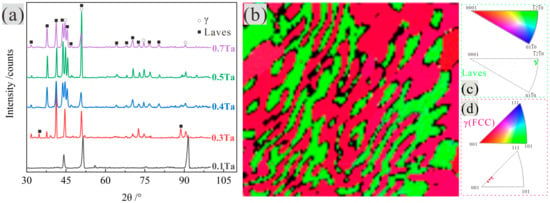
Figure 3.
(a) XRD patterns of as-cast CrCoNiTax alloys. (b) EBSD mapping of CrCoNiTa0.4 alloy. The γ (FCC) and Laves (HCP) phases. The corresponding EBSD inverse pole figure of (c) Laves phase and (d) γ phase.
Figure 3b shows the EBSD phase mapping of typical γ (FCC)/Laves (HCP) lamellar microstructures. Fine Laves lamellae (green color) were parallel to each other and distributed in the γ phase. In addition, some coarse Laves lamellae also appeared. The volume fraction of γ and Laves phases was about 66.39% and 33.61% respectively. Moreover, the two phases in eutectic have a special orientation relationship, which is related to the minimum phase interfacial energy. The corresponding EBSD inverse pole figures of Laves and γ phases are shown in Figure 3c,d respectively. The two phases achieve the minimum interfacial energy by adjusting the lamellar spacing, preferential growth orientation. In the eutectic alloy, the two phases have a certain preferred orientation, namely (hkl)α//(hkl)β, indicating the two-phase growth orientation is preferred in a certain crystallographic direction. This orientation is caused by the decrease in the total interfacial energy. Therefore, the two-phase orientation in CrCoNiTa0.4 is (001)γ//(20)Laves.
3.3. Assessment on the Phase Formation
The evolution of phases in CrCoNiTax, FCC or Laves in alloys, is easy to understand. The formation of single solid solutions in HEAs is accomplished by the reduction of the free energy and the high mixing entropy in alloy system. The Hume-Roseley’s rule is a good predictor of solid solution formation and there are four or five alloying elements in HEA, so the limitations in the Hume-Roseley rule may not be applicable. We use the thermodynamic and electronegativity parameters to establish the evolution of phase selection for MEAs. The parameter Ω is chosen to unveil that the systemic effect of the mixing entropy (ΔSmix), the mixing of the main components (ΔSmix), atomic size parameter and Valence Electron Concentration (VEC) on the phase formation is as follows [3,22,25]:
Here R is the gas constant, n is the number of the components in alloys, is the atomic percentage of ith component. Tm is the average melting temperature of the n elements, (Tm)i is the melting temperature of ith element, ri is the atomic radius of the element, and is the average atomic radius. The value of enthalpy in the alloys is three orders of magnitude larger than that of entropy, therefore we consider Tm = T, absolute temperature is assumed to be 1000 K for the linking between entropy and enthalpy for the CrCoNiTax alloy system. To further determine the component intervals of hyper-eutectic and hypo-eutectic, two additional components are introduced for discussion. As Ta solubility in CrCoNiTax which are taken from EDS results in Ta0.1 alloy for FCC and Ta0.7 alloy for Laves respectively. The FCC phase composition is Cr32.6Co32.8Ni33.1Ta1.5 denoted by x = FCC, the Laves phase composition is Cr23.8Co27.5Ni20.6Ta28.1 represented by x = Laves. The Ta in “x = FCC” is argued to be the maximum solubility, while Ta in “x = Laves” is probable solubility from the Laves phase, the detailed results are listed in Table 2.

Table 2.
Entropy of mixing (ΔHmix), enthalpy of mixing (ΔSmix), Ω, atomic size difference (δ), valence electron concentration (VEC) of the CrCoNiTax alloy system.
The ΔSmix increased from 10.02 J mol−1 K−1 (Ta0.1) to 11.44 J mol−1 K−1 (Ta0.7) with addition of Ta in CrCoNiTax and reached the maximum value of 11.46 J mol−1 K−1 for x = Laves. Similarly, the value of ΔHmix became more negative and lay in the range of −7.06 kJ mol−1 and −15.52 kJ mol−1 for Ta0.1 and Ta0.7, respectively. However, when x increased from 0.1 to 0.7, the value of Ω decreased from 1.42 to 0.74. This phenomenon indicated that Smix played a negative role for solid solution formation in CrCoNiTax compared to Hmix and was the determination of the transformation of the two-phase eutectic structure. As a result, the volume of the Laves phase, yield strength and hardness increased when Ta was added. Therefore, ΔHmix seemed to determine the reaction of eutectic between the different constituent elements. The more negative ΔHmix, the more chance of forming a two-phase structure [26]. Thus, ΔHmix reflected the driving force for forming the eutectic structure as the Ta possessed much negative ΔHmix alloying with other elements. Therefore, the decrease in the value of Ω contributed to the formation of eutectic.
Rules for solid solution formation in HEAs have been proposed by Zhang et al. [25], TCP phase will emerge when ΔHmix < −15 kJ mol−1 and δ 6.6%. In case of CrCoNiTax, the values have been modified to set as: −7.06Hmix−15.52, 2.765.39. Unfortunately, the rule proposed by Zhang et al. cannot accurately predict the formation of Laves phase in the CrCoNiTax alloy. The influence of Ta addition in CrCoNiTax on the changes of Ω and δ in CrCoNiTax alloys, single-phase FCC (x = FCC), and Laves phase (x = Laves) are presented in Figure 4. As the Ta content varies from x = 0.1 to x = 0.7, the value of δ increases from 2.76% to 5.39%, and Ω reduces from 1.42 to 0.74. Therefore, the stability of FCC phase is compromised with the increasing δ. The FCC phase is in the occupation of the left portion (δ 2.2%) and the Laves phase forms as the Ta content exceeds x = FCC and δ2.2%. Therefore, according to the previous discussion, Ta reduces the stability of FCC and promotes the formation of Laves, which is due to its large lattice distortion caused by the large difference in atomic size.
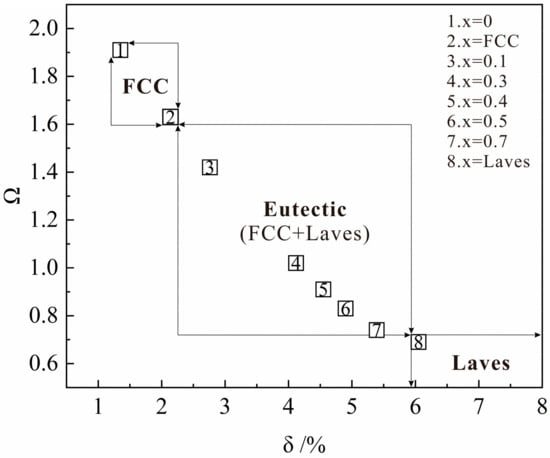
Figure 4.
Relationship between Ω and atomic size difference δ indicating the evolution of FCC, eutectic, and Laves regions.
It has been found that FCC phase is stable with VEC 8 and BCC phase is stable with VEC 6.87 [27]. CoCrMnFeNi (VEC = 8.27), CoCrFeNi (VEC = 8.25) and CrCoNi (VEC = 8.33) [13,28,29]. As for BCC phase, MoNbTaVW (VEC = 5.4) and MoNbTaW (VEC = 5.5) at VEC 6.87 [30]. Thus, VEC is a parameter that can effectively predict phase formation. Figure 5 illustrates that CrCoNi and x = FCC single-phase locate at VEC 8.25, while two phases (FCC + Laves) exist in the range of 7.5 VEC 8.25, and Laves phase (x = Laves) lies at VEC 7.5.
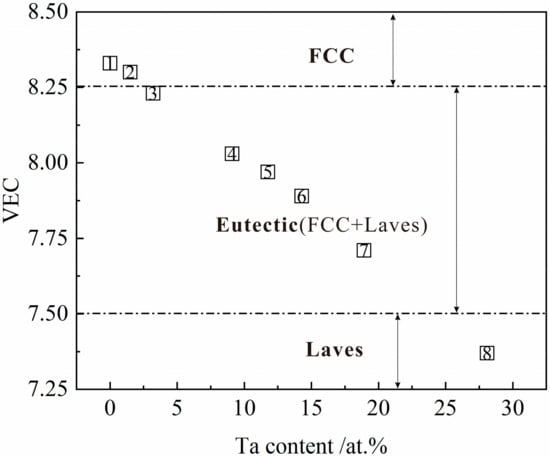
Figure 5.
The phase formation of FCC, eutectic, Laves on VEC versus Ta content in CrCoNiTax.
3.4. Mechanical Properties
Usually, the strength and plasticity of metals are challenging to obtain simultaneously. It is always desirable that a material be both strong and plastic, especially in advanced fields such as aerospace. How to increase the strength and plasticity of a material at the same time, or how to greatly increase the strength of a material without decreasing its plasticity, is a very challenging subject. The γ phase with FCC structure usually has good plasticity while the hard and brittle Lave phase with HCP structure is just the opposite of γ phase, having high strength and hardness. Therefore, the lamellar structure, containing both the highly plastic γ phase and the high-strength Laves phase, is promised to have both high strength and high plasticity simultaneously.
The load of 1000 g for hardness measurement has been selected to obtain the composite hardness. Figure 6 shows the variation of hardness with Ta content in the CrCoNiTax alloys, the hardest alloys is 632HIV when the x value reaches 0.7. According to the previous results, the increasing Ta addition causes the increasing volume fraction of Laves phase. The Laves phase in alloy is a hard and brittle phase of HCP structure, therefore with bigger volume fraction of Laves phase, comes higher hardness.
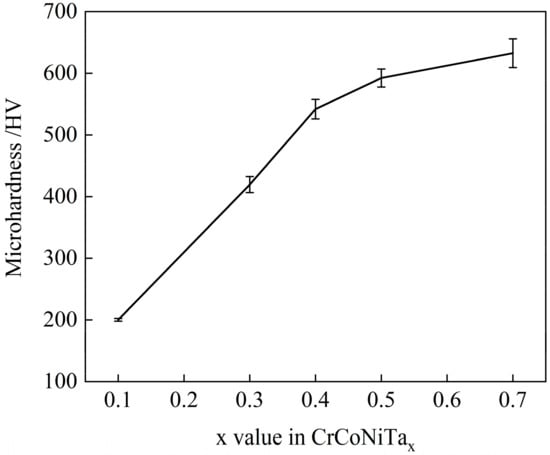
Figure 6.
Hardness of CrCoNiTax alloys.
To dig deeper into the correspondence between the microstructure evolution with Ta addition and the mechanical properties, nanoindentation was performed to analyze the mechanical properties of each phase in the alloys. Finally, the nano-hardness and elastic modulus of each phase of different microstructures, namely primary phase and eutectic structures were characterized.
The typical load-displacement curve of γ phase of Ta0.1 and Ta0.3, Laves phase of Ta0.5 and Ta0.7 in Figure 7a, eutectic in Ta0.3 Ta0.4 and Ta0.5 in Figure 7b. The detailed results were shown in Figure 7c,d. As shown in Figure 7a,c, the displacement curve of nanoindentation keeps decreasing, suggesting that the nano-hardness of the primary phase increases as Ta addition increased, from γ phase (3.81–5.23 GPa) to eutectic (9.01 GPa) and then to (15.73–16.59 GPa). The elastic modulus of each phase has the same trend as the nano-hardness variation. There was an important phenomenon, the nano-hardness of γ phase was evidently increased from 3.81 GPa (Ta0.1) to 5.23GPa (Ta0.3), this was a convincing evidence that solid solution strengthening in γ phase was significantly enhanced.
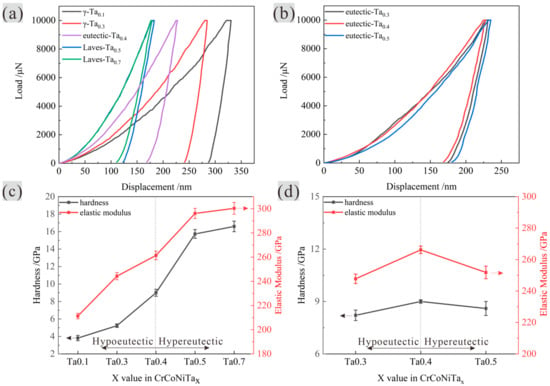
Figure 7.
Typical load-displacement curves (a), hardness and elastic modulus (c) of primary phase in Ta0.1, Ta0.3, Τa0.4, Ta0.5 and Ta0.7, typical load-displacement curves (b), hardness and elastic modulus (d) of eutectic in Ta0.3, Ta0.4 and Ta0.5.
As shown in Figure 7b,d, the nano-hardness and elastic modulus of eutectic firstly increased and then decreased. On one hand, the Ta0.4 has high uniformity of structure, on the other hand, lamellar spacing in Ta0.4 is much smaller. Therefore, nano-hardness and elastic modulus of eutectic of Ta0.4 alloy among all alloys were the highest.
The compression stress-strain curves are shown in Figure 8a, 0.2% yield stress and fracture strain are also presented in Figure 8b. Ta0.1 alloy did not fracture, which was similar to FCC phase, the alloy shows high ductility and low strength. When the Ta addition x varies from 0.3 to 0.7, the fracture properties firstly increased and then decreased, Ta0.7 alloy has the highest hardness and 0.2% yield strength, Ta0.4 alloy exhibits the strongest compression strength up to 2502 MPa with 20.6% compression plasticity. The mechanical properties results show that Ta0.4 alloy possesses both high ductility and high strength. The plastic strain of the alloy was significantly reduced from 33.4 to 6.5% due to the increasing volume fraction of the brittle and hard Laves phase.
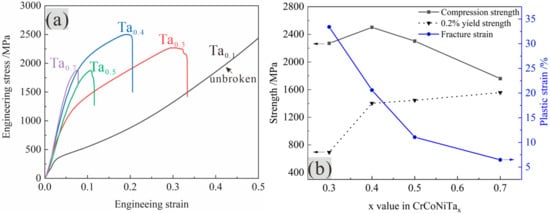
Figure 8.
(a) Compression engineering stress-strain curves; (b) compression strength, 0.2% yield strength and fracture strain of CrCoNiTax alloys.
Nanoindentation results show the nano-hardness of γ phase in Ta0.3 is higher than that in Ta0.1, EDS results also represent that more content of Ta dissolved into the γ phase. In addition, Ta exhibits large negative mixing enthalpy, the mixing enthalpy for Ta-Cr, Ta-Co, Ta-Ni are −7, −24 and −29 kJ mol−1, respectively [22]. Therefore, Ta causes an increase in the lattice strain, distortion and strengthens the γ FCC phase. Since the Laves phase is a hard and brittle intermetallic phase, it strengthens the alloy at the expense of ductility. The nano-hardness of Laves phase in Ta0.5 and Ta0.7 is very close. In fact, the coarse Laves phase formed in hyper-EMEAs can significantly damage the boundary strength [31]. Therefore, the plasticity and strength of Ta0.5 and Ta0.7 decreased sharply.
Nevertheless, the state of the lamellar structure in the eutectic alloy is also one of the important factors in the performance of the alloy. The relationship between yield strength and lamellar spacing has been successfully established according to a Hall-Petch equation. For the EMEA, the equation is as follows:
where σ* is a frictional stress, k is the Hall-Patch slope, and λ is the lamellar spacing. Eutectic in Ta0.3, Ta0.4 and Ta0.5 is chosen to ensure accuracy.
Figure 9 shows the mechanical properties of HEA with a typical eutectic structure and compares them with the results of this work, (CoFeNiV0.5Nbx [30], Co2MoxNi2VWx [32], CrCoFeNiNbx [11], CoCrFeNiTax [12], CoFeNiVMox [33]), alloys with full eutectic microstructure are described as “eutectic”. Compared with other alloys, EMEA CrCoNiTa0.4 possesses relatively good compression strength (2502MPa) and good plastic strain (20.6%) compared with EMEA CoCrFeNiTax (compression strength 2377 MPa, plastic strain 17.5%).
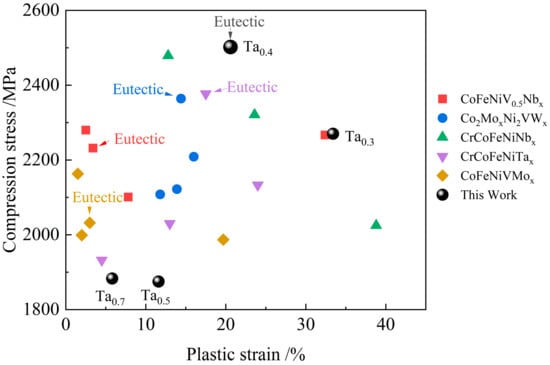
Figure 9.
Compression strength and plastic strain of some typical EHEAs compared with CrCoNiTax EMEA: CoFeNiV0.5Nbx [30], Co2MoxNi2VWx [32], CrCoFeNiNbx [11], CoCrFeNiTax [12], CoFeNiVMox [33] and CrCoNiTax(this wok).
4. Conclusions
The microstructure, phase characteristics and mechanical properties with Ta addition in CrCoNiTax MEAs are studied. The major conclusion are as follows:
- (1)
- CrCoNiTax alloys contain γ phase with FCC structure and Laves phase with C14 HCP structure. With increasing Ta content, it can be seen a complete transformation from hypoeutectic (Ta0.1 and Ta0.3) to hypereutectic (Ta0.5 and Ta0.7). As for Ta0.4 alloy, the Ta0.4 alloy exhibits a lamellar eutectic composition.
- (2)
- Assessment on the phase evolution is established on thermodynamic parameters (Ω), atomic size differences (δ), valence electron concentration (VEC) which are useful parameters to determine the formation of eutectic microstructure with FCC and Laves phase. The Laves phase evolves when δ 2.2 and VEC 8.25.
- 3)
- With increasing Ta addition, the microhardness of the alloys increased and the hardness of the γ phase increased. While the Laves phase hardness stayed unchanged. Ta0.4 alloy has the highest nano-hardness and elastic modulus due to the full complete eutectic structure with small lamellar spacing and enhanced solid solution strengthening.
- (4)
- With Ta addition increasing, the hard and brittle Laves phase is increasing, the plasticity of the alloy is decreasing, the compressive strength is increasing and then decreasing, The CrCoNiTa0.4 EMEA with complete eutectic has the best balance of microstructure and properties, highest compressive strength (2502 MPa) and plastic strain (20.6%).
Author Contributions
Conceptualization—T.H.; methodology—T.H. and J.Z. (Jiachen Zhang); supervision—J.Z. (Jun Zhang) and L.L.; writing—original draft preparation, T.H. and J.Z. (Jiachen Zhang).; writing—review and editing, T.H. All authors have read and agreed to the published version of the manuscript.
Funding
The authors gratefully acknowledge the financial support by the National Natural Science Foundation of China (52071267, 51631008), the National Key Research and Development Program of China (No.2016YFB0701400).
Institutional Review Board Statement
Not applicable.
Informed Consent Statement
Not applicable.
Data Availability Statement
Not applicable.
Conflicts of Interest
The authors declare no conflict of interest.
References
- Cantor, B.; Chang, I.; Knight, P.; Vincent, A. Microstructural development in equiatomic multicomponent alloys. Mater. Sci. Eng. A 2004, 375–377, 213–218. [Google Scholar] [CrossRef]
- Yeh, J.-W.; Chen, S.K.; Lin, S.-J.; Gan, J.-Y.; Chin, T.-S.; Shun, T.-T.; Tsau, C.-H.; Chang, S.-Y. Nanostructured High-Entropy Alloys with Multiple Principal Elements: Novel Alloy Design Concepts and Outcomes. Adv. Eng. Mater. 2004, 6, 299–303. [Google Scholar] [CrossRef]
- Zhang, Y.; Zuo, T.T.; Tang, Z.; Gao, M.C.; Dahmen, K.A.; Liaw, P.K.; Lu, Z.P. Microstructures and properties of high-entropy alloys. Prog. Mater. Sci. 2014, 61, 1–93. [Google Scholar] [CrossRef]
- Miracle, D.; Senkov, O. A critical review of high entropy alloys and related concepts. Acta Mater. 2017, 122, 448–511. [Google Scholar] [CrossRef] [Green Version]
- Tsai, M.-H.; Yeh, J.-W. High-Entropy Alloys: A Critical Review. Mater. Res. Lett. 2014, 2, 107–123. [Google Scholar] [CrossRef]
- Lu, Z.; Wang, H.; Chen, M.; Baker, I.; Yeh, J.; Liu, C.; Nieh, T. An assessment on the future development of high-entropy alloys: Summary from a recent workshop. Intermetallics 2015, 66, 67–76. [Google Scholar] [CrossRef] [Green Version]
- Hemphill, M.; Yuan, T.; Wang, G.; Yeh, J.; Tsai, C.; Chuang, A.; Liaw, P. Fatigue behavior of Al0.5CoCrCuFeNi high entropy alloys. Acta Mater. 2012, 60, 5723–5734. [Google Scholar] [CrossRef]
- Lu, Y.; Gao, X.; Jiang, L.; Chen, Z.; Wang, T.; Jie, J.; Kang, H.; Zhang, Y.; Guo, S.; Ruan, H.; et al. Directly cast bulk eutectic and near-eutectic high entropy alloys with balanced strength and ductility in a wide temperature range. Acta Mater. 2017, 124, 143–150. [Google Scholar] [CrossRef] [Green Version]
- Lu, Y.; Dong, Y.; Guo, S.; Jiang, L.; Kang, H.; Wang, T.; Wen, B.; Wang, Z.; Jie, J.; Cao, Z.; et al. A Promising New Class of High-Temperature Alloys: Eutectic High-Entropy Alloys. Sci. Rep. 2014, 4, srep06200. [Google Scholar] [CrossRef] [PubMed]
- Gao, X.; Lu, Y.; Zhang, B.; Liang, N.; Wu, G.; Sha, G.; Liu, J.; Zhao, Y. Microstructural origins of high strength and high ductility in an AlCoCrFeNi2.1 eutectic high-entropy alloy. Acta Mater. 2017, 141, 59–66. [Google Scholar] [CrossRef]
- He, F.; Wang, Z.; Cheng, P.; Wang, Q.; Li, J.; Dang, Y.; Wang, J.; Liu, C. Designing eutectic high entropy alloys of CoCrFeNiNb x. J. Alloys Compd. 2016, 656, 284–289. [Google Scholar] [CrossRef]
- Ai, C.; He, F.; Guo, M.; Zhou, J.; Wang, Z.; Yuan, Z.; Guo, Y.; Liu, Y.; Liu, L. Alloy design, micromechanical and macromechanical properties of CoCrFeNiTax eutectic high entropy alloys. J. Alloys Compd. 2018, 735, 2653–2662. [Google Scholar] [CrossRef]
- Laplanche, G.; Kostka, A.; Reinhart, C.; Hunfeld, J.; Eggeler, G.; George, E. Reasons for the superior mechanical properties of medium-entropy CrCoNi compared to high-entropy CrMnFeCoNi. Acta Mater. 2017, 128, 292–303. [Google Scholar] [CrossRef]
- Zhang, Z.; Sheng, H.; Wang, Z.; Gludovatz, B.; Zhang, Z.; George, E.P.; Yu, Q.; Mao, S.X.; Ritchie, R.O. Dislocation mechanisms and 3D twin architectures generate exceptional strength-ductility-toughness combination in CrCoNi medium-entropy alloy. Nat. Commun. 2017, 8, 14390. [Google Scholar] [CrossRef] [PubMed]
- Gludovatz, B.; Hohenwarter, A.; Thurston, K.V.S.; Bei, H.; Wu, Z.; George, Z.W.E.P.; Ritchie, B.G.K.V.S.T.R.O. Exceptional damage-tolerance of a medium-entropy alloy CrCoNi at cryogenic temperatures. Nat. Commun. 2016, 7, 10602. [Google Scholar] [CrossRef] [PubMed]
- Okamoto, H. Cr-Ta (chromium-tantalum). J. Phase Equilibria Diffus. 1996, 17, 457. [Google Scholar] [CrossRef]
- Okamoto, H. Co-Ta (Cobalt-Tantalum). J. Phase Equilibria Diffus. 2004, 25, 571–572. [Google Scholar] [CrossRef]
- Okamoto, H. Ni-Ta (Nickel-Tantalum). J. Phase Equilibria Diffus. 2000, 21, 497. [Google Scholar] [CrossRef]
- Zhang, J.; Huang, T.; Cao, K.; Chen, J.; Zong, H.; Wang, D.; Zhang, J.; Zhang, J.; Liu, L. A correlative multidimensional study of γ′ precipitates with Ta addition in Re-containing Ni-based single crystal superalloys. J. Mater. Sci. Technol. 2021, 75, 68–77. [Google Scholar] [CrossRef]
- Sato, J.; Omori, T.; Oikawa, K.; Ohnuma, I.; Kainuma, R.; Ishida, K. Cobalt-Base High-Temperature Alloys. Science 2006, 312, 90–91. [Google Scholar] [CrossRef]
- Santodonato, L.J.; Zhang, Y.; Feygenson, M.; Parish, C.; Gao, M.C.; Weber, R.J.; Neuefeind, J.C.; Tang, Z.; Liaw, P.K. Deviation from high-entropy configurations in the atomic distributions of a multi-principal-element alloy. Nat. Commun. 2015, 6, 5964. [Google Scholar] [CrossRef] [PubMed] [Green Version]
- Takeuchi, A.; Amiya, K.; Wada, T.; Yubuta, K.; Zhang, W.; Makino, A. Entropies in Alloy Design for High-Entropy and Bulk Glassy Alloys. Entropy 2013, 15, 3810–3821. [Google Scholar] [CrossRef]
- Tsai, M.-H.; Fan, A.-C.; Wang, H.-A. Effect of atomic size difference on the type of major intermetallic phase in arc-melted CoCrFeNiX high-entropy alloys. J. Alloys Compd. 2017, 695, 1479–1487. [Google Scholar] [CrossRef]
- Shinagawa, K.; Chinen, H.; Omori, T.; Oikawa, K.; Ohnuma, I.; Ishida, K.; Kainuma, R. Phase equilibria and thermodynamic calculation of the Co–Ta binary system. Intermetallics 2014, 49, 87–97. [Google Scholar] [CrossRef]
- Zhang, Y.; Zhou, Y.J.; Lin, J.P.; Chen, G.L.; Liaw, P.K. Solid-Solution Phase Formation Rules for Multi-component Alloys. Adv. Eng. Mater. 2008, 10, 534–538. [Google Scholar] [CrossRef]
- Liu, W.; He, J.; Huang, H.; Wang, H.; Lu, Z.; Liu, C. Effects of Nb additions on the microstructure and mechanical property of CoCrFeNi high-entropy alloys. Intermetallics 2015, 60, 1–8. [Google Scholar] [CrossRef]
- Guo, S.; Ng, C.; Lu, J.; Liu, C.T. Effect of valence electron concentration on stability of fcc or bcc phase in high entropy alloys. J. Appl. Phys. 2011, 109, 103505. [Google Scholar] [CrossRef] [Green Version]
- Otto, F.; Yang, Y.; Bei, H.; George, E. Relative effects of enthalpy and entropy on the phase stability of equiatomic high-entropy alloys. Acta Mater. 2013, 61, 2628–2638. [Google Scholar] [CrossRef] [Green Version]
- King, D.; Middleburgh, S.; McGregor, A.; Cortie, M. Predicting the formation and stability of single phase high-entropy alloys. Acta Mater. 2016, 104, 172–179. [Google Scholar] [CrossRef]
- Jiang, L.; Lu, Y.; Dong, Y.; Wang, T.; Cao, Z.; Li, T. Effects of Nb addition on structural evolution and properties of the CoFeNi2V0.5 high-entropy alloy. Appl. Phys. A 2015, 119, 291–297. [Google Scholar] [CrossRef]
- Huo, W.; Zhou, H.; Fang, F.; Zhou, X.; Xie, Z.; Jiang, J. Microstructure and properties of novel CoCrFeNiTax eutectic high-entropy alloys. J. Alloys Compd. 2018, 735, 897–904. [Google Scholar] [CrossRef]
- Jiang, H.; Zhang, H.; Huang, T.; Lu, Y.; Wang, T.; Li, T. Microstructures and mechanical properties of Co2MoxNi2VWx eutectic high entropy alloys. Mater. Des. 2016, 109, 539–546. [Google Scholar] [CrossRef]
- Jiang, L.; Cao, Z.; Jie, J.; Zhang, J.; Lu, Y.; Wang, T.; Li, T. Effect of Mo and Ni elements on microstructure evolution and mechanical properties of the CoFeNixVMoy high entropy alloys. J. Alloys Compd. 2015, 649, 585–590. [Google Scholar] [CrossRef]
Publisher’s Note: MDPI stays neutral with regard to jurisdictional claims in published maps and institutional affiliations. |
© 2021 by the authors. Licensee MDPI, Basel, Switzerland. This article is an open access article distributed under the terms and conditions of the Creative Commons Attribution (CC BY) license (https://creativecommons.org/licenses/by/4.0/).